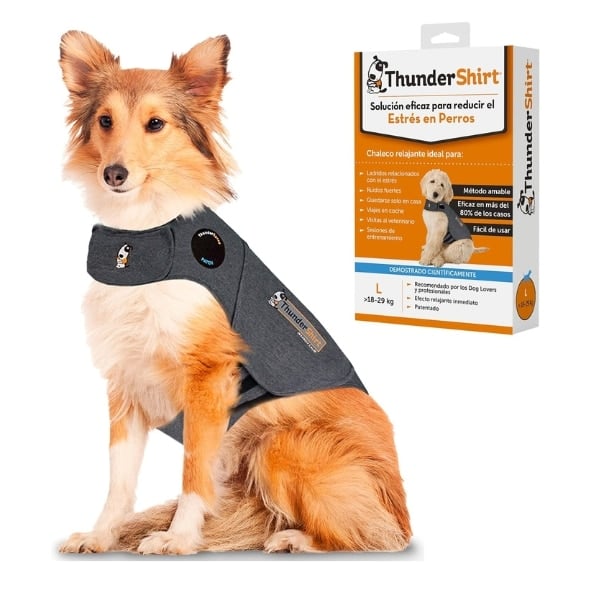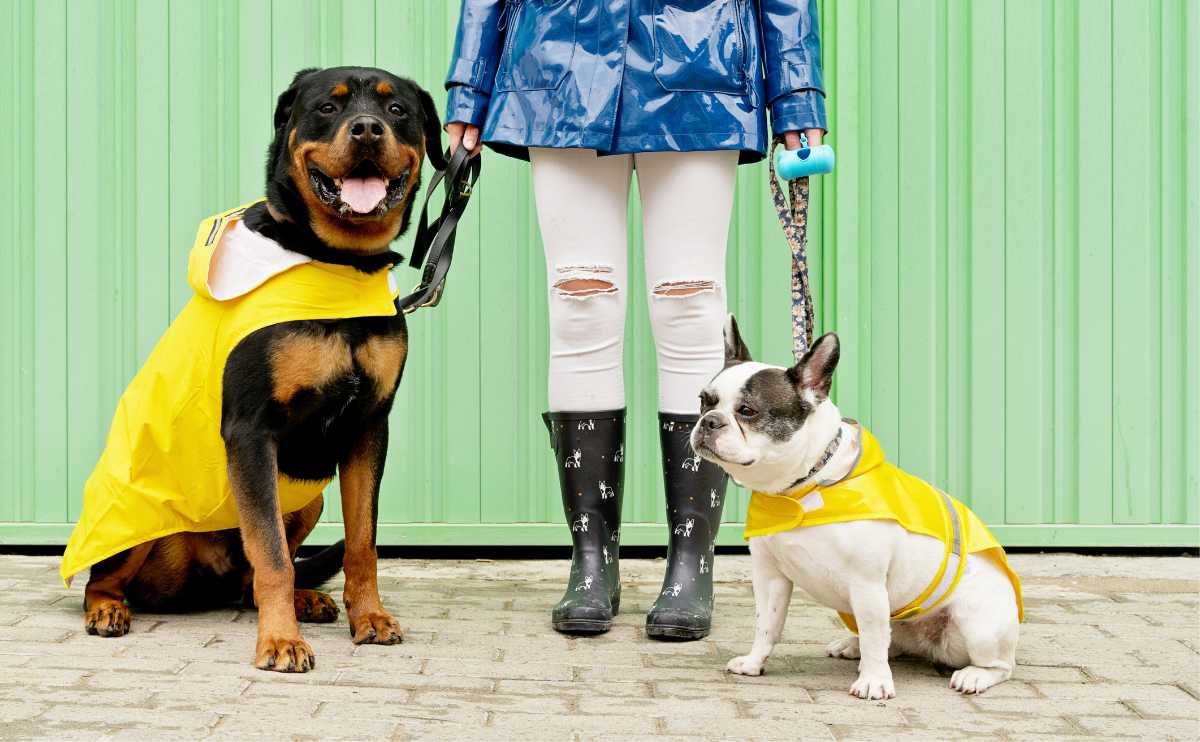When you purchase through links on our site, we may earn a commission. Here’s how it works.

Does your dog howl at thunder or bark during fireworks? You’re not alone. Noise phobias are one of the most common anxiety-related complaints of dog owners. There are also many other nerve-inducing situations for dogs, and my dog, Lily, suffers from nearly all of them. Luckily, the Thundershirt has been a big help in reducing her anxiety in stressful circumstances.
Let’s examine everything you ever wanted to know about noise-related phobias in dogs, the ThunderShirt solution, and how the ThunderShirt works to put dogs at ease.
Note: the ThunderShirt is also known as a type of jacket, stress-relief wrap, or anxiety vest.
- Why Are Dogs Afraid Of Thunder?
- Shelter Dogs Are Also Prone To Storm Noises
- Phobia Symptoms
- How To Handle Thunder Phobias In Dogs
- What Is A ThunderShirt?
- How Does It Work?
- Does It Work For All Dogs?
- What Is A Multi-Pronged Approach To Canine Anxiety?
- Why Try The ThunderShirt First?
- Tips For Dealing With Dogs And Fireworks
- Why Trust Canine Journal?
Why Are Dogs Afraid Of Thunder?
Many dogs experience thunder phobias (or other noise-related phobias), but these can be frustrating and often incomprehensible to pet owners. How can a well-treated dog be so afraid of something?
The truth behind thunder phobias is that no one knows why dogs are afraid of thunderstorms. Many veterinarians have conjectured about specific parts of the storm that cause a fear response, yet no one is sure which one has the most significant impact.
Behaviorists have been studying thunder phobias for years, including sounds from thunder, wind, and rain and the impact of lightning. Some researchers even studied the impact of air pressure changes and electrical charges to pinpoint a cause for thunder phobia. Still, unfortunately, there are no definitive answers to date.
Nature vs Nurture And Storm Phobias
There is some evidence indicating that at least part of the storm phobia comes from a natural predisposition.
A study published in the Journal of the American Animal Hospital Association describes a relationship between certain dog breeds and the presence of storm phobias. Interestingly, most of the dog breeds in the study described as having a predisposition to storm phobias were working or sporting breeds, such as German shepherds, collies, and hounds.
The study’s authors believe that this predisposition to a thunder phobia directly results from breeding for specific characteristics in these dogs. Bred dogs react quickly to stimuli, not only in working situations but also in the presence of other strong stimuli. These trained breeds respond to stimuli with a specific response.
However, when they are startled by strong stimuli such as thunder, there is no “go-to” response other than the knowledge that aggression is not acceptable. So, what does a dog do with this startling response if they’re trained not to react with fear? This study suggests that they respond instead with anxiety.
Shelter Dogs Are Also Prone To Storm Noises
In addition to studying dogs with a genetic predisposition to thunder phobias, the research also took a look at rescued shelter dogs, as they also tend to have a higher rate of storm-related phobias.
Unfortunately, due to many of these dogs’ unknown backgrounds, researchers can only imagine the reason behind their phobias. The common belief is that many of these dogs were abused or abandoned and lacked socialization and exposure to a wide range of stimuli.
All of these factors can contribute to fear. Dogs that do not receive adequate socialization or exposure to varied stimuli are more prone to fear of the unknown and are often less outgoing and adventurous.
View on Amazon | View on Chewy | View on Walmart
Phobia Symptoms
There are many different types of phobias in dogs, but the most prominent are noise-based phobias and separation anxiety. Each dog may exhibit different signs of these phobias, but some of the most common symptoms include:
- Tail tucking
- Hiding (particularly under beds or in closets)
- Howling
- Trembling or shaking
- Pacing
- Excessive drooling
- Panting
- Chewing
- Paw licking
- Destruction (such as ripping trash bags open or ripping the sofa cushions)
- Defecating or urinating in the house
- Lap sitting (particularly noticeable in bigger dogs)
- Barking, crying, and whining
How To Handle Thunder Phobias In Dogs
Handling any fearful dog can be difficult, so it is important to know what to expect. If the dog you are working with is unfamiliar to you, you should be on guard and keep your eye on the dog at all times. This is because some dogs will react to fear by snapping, and if you are unfamiliar with a particular dog, it won’t be easy to read their behavior and their responses to various stimuli.
The best resource for tackling any fear-related problem in a dog is to speak with your veterinarian. Your vet will understand your pet’s needs and your relationship with your pet and make a recommendation based on that alone. If a dog seems overly aggressive due to fear, you should always contact a professional canine behaviorist and trainer experienced with fear responses to phobias.
What Is A ThunderShirt?

View on Amazon | View on Chewy | View on Walmart
The ThunderShirt is a non-medicinal approach to treating fear response in dogs. This anxiety vest or type of Thunder Jacket for dogs is the preferred treatment choice for non-aggressive, fear-response pups. The ThunderShirt is a garment or vest with adjustable fasteners that come in a variety of sizes. Made from a durable and washable fabric, it compresses much like Spandex does for humans.
How Does It Work?
Just as swaddling new babies can help them feel more secure, the compression from a ThunderShirt can help anxious dogs feel more confident. The pressure applied by the ThunderShirt has a calming effect that allows approximately 80 percent of dogs with anxiety to feel relief.
The concept of using pressure to relieve anxiety has been used in medicine for humans as well. For example, many psychiatric dogs train to lie on top of their autistic or PTSD masters to relieve their anxiety by applying body weight.
Does It Work For All Dogs?
Unfortunately, no one solution works for everyone, and the same goes for a thunder jacket for dogs.
80% of dogs suffering from anxieties associated with noise, fireworks, thunderstorms, separation, travel, crate, or barking benefit from the ThunderShirt.
Many dogs also benefit from the ThunderShirt when used in conjunction with other therapy methods, like behavioral training. A small percentage of dogs with anxiety don’t show improvement with the application of the ThunderShirt. ThunderShirt offers a 100% money-back guarantee in these cases, ensuring if the shirt doesn’t work for your dog’s anxiety, you receive a full refund.
Why doesn’t the ThunderShirt work for all dogs? Just as with the human psyche, many components contribute to fear and anxiety. There are also many factors that influence how a dog calms down. While compression works for many dogs, this is not always the case. For some dogs with deep-rooted anxiety, the ThunderShirt alone is not enough to remove the fear compounded over ThunderShirt. For these dogs, a multi-pronged therapy approach is recommended.
What Is A Multi-Pronged Approach To Canine Anxiety?
There is no way to know precisely how your dog will respond to any particular therapy directed toward their anxiety. Fortunately, many solutions work together to create a multi-pronged treatment program. Behavioral therapy with a professional trainer and a ThunderShirt is one of the most recommended treatment programs.
For some dogs, this is not enough to defeat years of fear and anxiety. For these dogs, vets often recommend pheromone solutions that include DAP and calming collar disks. Other solutions include essential oils, CBD oils or CBD treats, herbal dog collars, and even calming music.
Tip: CBD is a natural product that can treat anxiety in humans and pets. We have researched and tried several different CBD oils and treats to find the best for dogs on the market today. Learn more about CBD’s benefits for dogs and how it can help calm your pet’s stressed-out nerves.
Visit HolistPet’s website, our top-rated CBD company
If these non-medicinal treatments fail, then holistic vets recommend seeking out herbal remedies before turning to prescription drugs, which can have serious side effects.
For some dogs, prescription anxiety medications like Clomipramine can help. Canine anti-anxiety drugs are much like human anti-anxiety drugs and work by influencing the neurotransmitters in the brain. These medications work well for dogs with no pre-existing medical conditions other than severe anxiety and those who have not responded to other non-prescription treatments.
Why Try The ThunderShirt First?
Here are a few reasons you should consider the ThunderShirt before resorting to other anxiety solutions with dogs.
- An affordable and straightforward solution
- Does not present the potential for side effects that come with other anxiety treatments
- Easy to put on and has Velcro closures, making it adjustable
- Can be cleaned and put through the washing machine to maintain cleanliness
- Designed to be safe for use over extended periods (consideration must be given to the external temperature to avoid the possibility of overheating)
The concept of the ThunderShirt is to provide a feeling of security, often addressing the most significant cause of anxiety in anxious dogs – feeling insecure and unsafe. The ThunderShirt for dogs sells for $40.99 and, more recently, the ThunderShirt company also released a ThunderShirt for cats that sells for $44.95 and functions much the same way that the canine does.
Tips For Dealing With Dogs And Fireworks
Be sure to check out our tips to keep Fido calm during fireworks for additional ways to keep your pup safe and sound during festivities for the Fourth of July.
Why Trust Canine Journal?
Michelle has been a dog owner her entire life. She has a dog with many anxiety concerns that have benefitted from using the ThunderShirt. She’s also managed Lily’s stress with CBD, supplements, and lots of loving cuddles. She’s part of a team of dog specialists at Canine Journal who have nearly two decades of experience researching, testing, and writing about everything you need to know to keep your pup healthy and happy.
Tagged With: Anxiety, CBD

